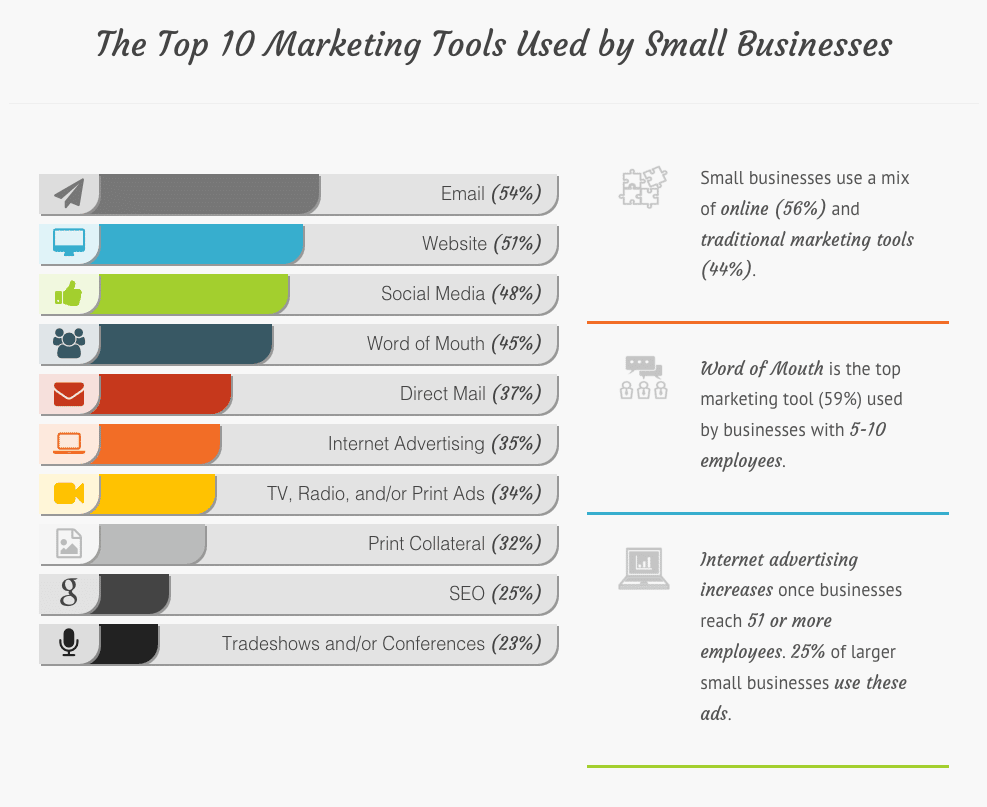Figuring out the best way to market your business can be a challenging task. The proliferation and saturation of technology can make any small business owner feel overwhelmed without a clear direction of what the right marketing mix should be to make the largest impact. In a previous blog post, I highlighted 17 inbound marketing tools you should be using – this is a great place to get started in terms of exploring various tools and deciding which will be the best fit for you. But first, let’s check out a few stats surrounding the state of small businesses for this year:
1) Strategies small businesses will focus on to improve growth
With 71% of small businesses expecting an increase in revenue, the following strategies are what small businesses will focus on to improve growth:

2) The top 10 marketing tools small businesses are using
62% of small businesses plan to invest 4% or more of their revenue in marketing. As such, here are the following tools they will use:

3) How small businesses are leveraging digital marketing
This stat still surprises me given the massive amount of digital technologies available for small businesses to target and connect with their customers – only 80% of small businesses use social media and many continue to underutilize SEO, blogging and video. More specifically:
- 34% of small businesses use social media to solicit and respond to customers
- 45% of small businesses use social media to sell to potential customers
- 54% of small businesses outsource graphic design and website design
- 12% of small businesses outsource their marketing, public relations and advertising
(Note: To review the entire 2016 State of Small Business Report, go here.)
With all of the above in mind, let’s dive in deeper on how your small business can execute the right digital marketing mix to generate growth, awareness, and retention…
Develop Your Own Funnel
In a previous blog post, I provided a marketing funnel as an example to help with customizing the buyer’s journey to better understand expectations as well as executions within each phase:

Further, a funnel like this works well when you’ve already narrowed down which tactical executions need to take place. The struggle behind misplaced advertising dollars comes down to not having a clear marketing strategy which has always plagued startups, small businesses and entrepreneurs (fast fact: 50% of companies fail within their first five years of being in business). There are so many resources that talk about what you should be doing and so many marketing tactics you should be implementing that the ability to actually focus becomes an even larger challenge.
So, what do you do?
Start by dissecting your funnel and identify where you are facing the most challenges. Break down your challenges into the following buckets:
- Need more awareness because no one knows who you are and what you do
- Need more leads because there isn’t enough new potential business in the pipeline
- Need more sales to scale and stay in business
- Need to sustain and increase retention because current customers are the lowest hanging fruit
For instance, something I hear a lot is, “We definitely want more awareness, but we care most about getting new leads and customers. We also don’t need to focus much on retention because our product/service is sticky and people will stick around.” Every time I hear this, a major red flag always pops up for the following reason: If all you care about is getting awareness, consideration and conversions for new customers, then you miss out on opportunities with your existing customers (such as up-sells, fleshed out reviews, referrals, earned media and of course, gaining the raving fans who are going to sell your products/services for you).
Strive for a Healthy Balance
Prioritize tactics that align best with what you’re trying to achieve. From there, allow flexibility to pivot and add more implementations. That way, you can focus on specifics, yet go broad when needed. Here’s an example:
- Phase One: Need more awareness because no one knows who you are and what you do
- Tactics include: Display advertising, content (blogging, videos, webinars), social media
- Phase Two: Need more leads because there isn’t enough new potential business in the pipeline; Need more sales to scale and stay in business
- Tactics (for leads) include: Content (blogging, videos, webinars), email, trade shows, SEO personalized product demos, phone calls, display/search advertising
- Phase Three: Need to sustain and increase retention because current customers are the lowest hanging fruit
- Tactics include: Email, social media, community building, in-product promotions
Lastly, make sure you are collecting data along the way. Doing so will help you make wiser decisions that will positively impact growth. If you’re still not sure about where to really get started, feel free to check a few of the free marketing resources created just for you here.






One Response